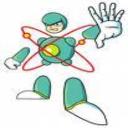Yahoo Answers is shutting down on May 4th, 2021 (Eastern Time) and beginning April 20th, 2021 (Eastern Time) the Yahoo Answers website will be in read-only mode. There will be no changes to other Yahoo properties or services, or your Yahoo account. You can find more information about the Yahoo Answers shutdown and how to download your data on this help page.
Trending News
Mass suspended from a boom? Physics Statics?
A mass M=179 kg is suspended from the end of a uniform boom as shown. The boom (mass=66.0 kg, length=2.40 m) is at an angle θ=60.0 deg from the vertical, and is supported at its mid-point by a horizontal cable and by a pivot at its base. Calculate the tension in the horizontal cable.
1 Answer
- electron1Lv 79 years agoFavorite Answer
mass M=179 kg is suspended from the end of a uniform boom as shown. The boom (mass=66.0 kg, length=2.40 m) is at an angle θ=60.0 deg from the vertical, and is supported at its mid-point by a horizontal cable and by a pivot at its base. Calculate the tension in the horizontal cable.
This is a torque problem. The pivot point is at the point where the lower end of the boom is attached to the vertical wall.
The weight of the boom and the tension in the vertical cable are causing clockwise torque. The tension in the vertical cable is equal to the weight of the suspended object.
The tension in the horizontal cable is causing a counter clockwise torque.
The weight of the boom is located at its center. The horizontal distance from the pivot point to the center of the boom is equal to the length of the horizontal string.
Length of the horizontal string = ½ * 2.40 * sin 60
Torque caused by weight of boom = (66 * 9.8) * (½ * 2.40 * sin 60)
Horizontal distance from the pivot point to vertical cable = 2.40 * sin 60
Torque caused by the tension in the vertical cable = (179 * 9.8) * (2.40 * sin 60)
These two torques cause the boom to rotate clockwise.
The vertical distance from the pivot point to horizontal cable = 2.40 * cos 60
Torque caused by tension in the horizontal cable = T * 2.40 * cos 60
This torque causes the boom to rotate counter clockwise.
Counter clockwise torque = Total clockwise torque
T * 2.40 * cos 60 = [(66 * 9.8) * (½ * 2.40 * sin 60)] + [(179 * 9.8) * (2.40 * sin 60)
Solve for T
Since the weights are downward forces, there must be an upward force. The upward force is located at the pin joint at the lower end of the boom.





